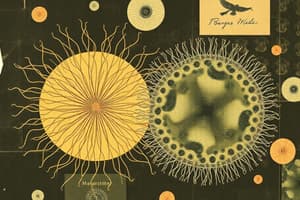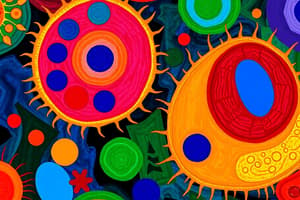Podcast
Questions and Answers
What is the smallest unit that can be considered alive?
What is the smallest unit that can be considered alive?
- Organ
- Tissue
- Cell (correct)
- Subsystem
In multicellular organisms, how do subsystems function?
In multicellular organisms, how do subsystems function?
- They remain dormant until needed.
- They interact to form specialized tissues and organs. (correct)
- They compete for resources to survive.
- They operate independently of each other.
What role do graphs and charts play in studying data?
What role do graphs and charts play in studying data?
- They help recognize chaotic trends in data.
- They distract from identifying important information.
- They reveal patterns that can be analyzed. (correct)
- They contain unrelated information.
What is the significance of cause and effect relationships in scientific study?
What is the significance of cause and effect relationships in scientific study?
Which of the following terms refers to organisms that transmit infectious diseases?
Which of the following terms refers to organisms that transmit infectious diseases?
Flashcards
Cause
Cause
A change or event that causes something else to happen.
Effect
Effect
The result of a change or event.
Microbe
Microbe
A living thing, often microscopic, that can cause disease.
Pattern
Pattern
Signup and view all the flashcards
Vector
Vector
Signup and view all the flashcards
Study Notes
Multicellular Organisms
- Multicellular organisms are systems of interacting subsystems.
- Subsystems are groups of cells forming tissues and organs.
- Organs specialize in specific body functions.
- All living things are made of cells.
- Cells are the smallest living units.
- Organisms can be single-celled (unicellular) or multi-celled (multicellular).
Cause and Effect
- Cause and effect relationships can predict phenomena in systems (natural or designed).
Patterns
- Graphs, charts, and images show repeating and predictable patterns in data.
Microscopes
- Students should know how to use a microscope.
- Students should know the parts of a microscope.
Vocabulary
- Evidence: Proof or information supporting a conclusion.
- Infectious: Capable of spreading disease.
- Pattern: A recurring characteristic or design.
- Trade-offs: Sacrificing one benefit for another.
- Vector: An organism that transmits disease.
- Microbe: A microscopic organism (like bacteria or viruses).
Studying That Suits You
Use AI to generate personalized quizzes and flashcards to suit your learning preferences.



